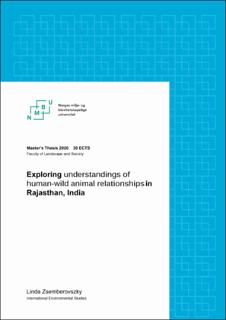| dc.description.abstract | India diverse human and wild animal populations share the place with each other for long time. Their relations are dynamic, ambiguous and complex, however it is often framed as conflict in a dualist perspective of separating ‘nature’ from ‘society’ as the dominant conservation discourse does. However, there might be other expressions of these relations in located histories and situated practices. Human-wild animal relations are usually embedded in relationships people have with their surroundings. Consequently, each place has specific histories of relations according to the dynamic and located political, economic, developmental, social and biophysical matters and discourses. I explored how relations between wildlife and people emerge and how they are influenced by different discourses, practices and politics in Mohammad Phalasiya village in Udaipur District, Rajasthan. For this task I applied material semiotics and conducted semi-structured interviews in the village, examined the regulatory framework regarding conservation of wildlife and tried to explore the history of human-wild animal relations. For historical changes can help to understand the relationship between people and wild animals in their dynamism. The interaction between wild animals and the participants in Mohammad Phalasiya is ambiguous and complex. Their relationship can be characterised by avoidance, tolerance, conflict, respect, fear and killing at the same time. This results from ‘historically situated animals in relations with situated humans’, the long time of sharing the same land and resources Wild animals shape human practices and perceptions as well as humans shape wild animals’ behaviour. This involves constants negotiations of resources and spaces which are part of their everyday life. | en_US |

